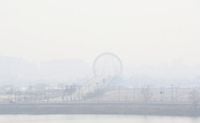Severe air pollution has engulfed South Korea in recent days, prompting health advisories across various regions as a hazardous combination of fine dust and yellow dust from China plagues the atmosphere. As of March 26, 2025, Jeonbuk Province is under a warning for 'bad' levels of fine dust, advising residents to exercise caution when outdoors.
On March 25, 2025, the situation escalated when the Ministry of Environment issued a fine dust alert for most of the country due to high concentrations of particulate matter (PM10). Reports indicate that levels classified as 'very bad' were observed across much of South Korea, with particular attention drawn to major urban areas including Seoul. The hourly average fine dust concentration in Seoul reached 247 micrograms per cubic meter, while Gyeonggi Province reported significantly higher figures ranging from 270 to 311 micrograms per cubic meter in some districts.
As highlighted by South Korea's Environment Corporation, on this day, fine dust levels were categorized as critically damaging with some regions seeing results in excess of 300 micrograms per cubic meter for over two hours, triggering a response from the government. For instance, in Gangwon Province, particularly in Hwacheon, fine dust concentration peaked at an alarming 312 micrograms per cubic meter.
Weather forecasts for the following day indicated a slight improvement, with Jeongbuk expected to have clearer skies by March 26, but caution remained due to lingering air pollutants. The forecast did predict a transition toward moderate air quality levels, with fine dust watches anticipated throughout various regions, including Yeongdong and Yeongseo in Gangwon Province.
Health officials have been particularly concerned because the combination of fine dust and ultrafine dust levels remains high. On March 25, ultrafine dust (PM2.5) advisories were registered across most of the country, and counts showed 40 to 50 micrograms per cubic meter of particulate matter. Citizens were advised to remain indoors and wear masks to mitigate health risks, especially for vulnerable populations.
On the same day, the Seoul Health and Environment Research Institute pointed to the origins of this pollution, indicating that the yellow dust arriving from the Gobi Desert contributed to the deteriorating conditions. The interfusion of this yellow dust with local pollutants exacerbated air quality issues. Reports prior to this indicated that the impacts of stagnant air led to a build-up of existing fine dust without a chance to disperse, further intensifying the problem.
As residents faced unseasonably high dust levels, environmental officials urged them to take extra precautions and avoid outdoor activities. Chuncheon locals expressed their frustrations; many were spotted wearing masks while commuting, and one resident noted, “It’s frightening to go outside; my throat hurts,” reflecting the widespread anxiety about air quality.
Looking forward, air quality predictions suggested an improvement coming soon, with a turnaround expected from the evening of March 25. The Environment Department anticipated that increased vertical mixing in the atmosphere would help reduce particulate matter levels as the weather improved. However, concerns regarding the health impacts of prolonged exposure to poor air quality lingered.
Simultaneously, inadequacies in air quality management have raised questions among residents and health experts about the government's preparedness for such environmental challenges. As smog and fine dust continue to pose risks to public health, it spurs dialogues surrounding the need for effective strategies to tackle pollution comprehensively and innovatively.
Meanwhile, across the South Korean health landscape, calls for public education on air quality issues have surged. Many citizens are pushing for more transparent reporting on air quality levels while advocating for systematic changes to address the underlying causes of pollution. The pressing concern emphasizes not only immediate responses to air quality alerts but also the necessity for long-term solutions, with governmental action strongly urged by environmental activists.
In view of these events, experts continue to monitor air quality while providing guidance to the public on how to protect themselves from the ongoing pollution crisis. With continued reports of dangerous levels of fine dust expected through the following days, vigilance remains necessary as South Korea navigates this environmental challenge.


![[오늘의 날씨]전북(26일, 수)…미세먼지 농도 '나쁨' 외출 주의 : 네이트 뉴스](https://thumbor.evrimagaci.org/W1QTfNayOD9K2LcWSDRGlbgBzAE=/200x0/tpg%2Fsources%2Febcf3b0e-13e8-47e0-8024-2756ce0416d3.jpeg)



